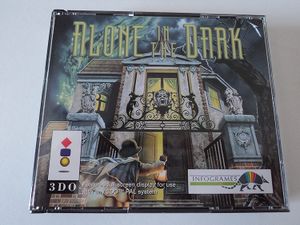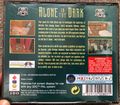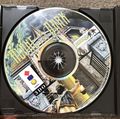Alone in the Dark(EU)

Overview
- Full Name: Alone in the Dark
- Code:
- Type: Survival horror
- Developer: I-Motion, Krisalis Software
- Publisher: Infogrames
- Language: English, French
- Release Date: August 3, 1994
- Region: EU
- Barcode: 3 329720 008071
- Local Title:
- Rarity: 1
- Notes: Not sure why, but there was a NTSC EU version released (EU NTSC Version)
Summary
Alone in the Dark is a survival horror video game designed by Frédérick Raynal and developed and published by Infogrames for the PC. Alone in the Dark was released for the 3DO in 1994 (Being ported by Krisalis in 1994). Set in 1920s Louisiana, the game challenges the player to guide the player character out of a haunted mansion, advancing by solving puzzles while either banishing, slaying, or eluding various ghosts and monsters. The player can collect and use weapons, manage a weight-based inventory system, and explore a partially nonlinear map.
Alone in the Dark received critical acclaim upon its release, and is considered a breakthrough and influential title, as it was the first 3D survival horror game. Among the accolades which followed its release, Alone in the Dark received the European Computer Trade Show awards for Best Graphics and Most Original Game in 1993. In 2009, Empire included Alone in the Dark on their list of 100 greatest video games of all time.
Alone in the Dark is considered a forefather of the survival horror genre, and its influence can be seen in the Resident Evil franchise. Alone in the Dark has also spawned four follow-up games as part of the series, as well as two films loosely based on them.
Alone in the Dark was published by Infogrames in Europe, Interplay in the US and Pony Canyon in Japan.
Gameplay
Players choose between a male or female protagonist (Edward Carnby or Emily Hartwood respectively), and are then trapped inside the haunted mansion of Derceto. The player character starts in the attic, having ascended to the top of the mansion without incident, and is tasked with finding a way out of the mansion while avoiding, outsmarting or defeating various supernatural enemies including slave zombies and giant bipedal rat-like creatures. Though able to kill most enemies with simply fists and feet, the player character can also find and utilize various weapons.
Many opponents can be beaten by solving a particular puzzle rather than a straight fight—indeed, a significant number of opponents cannot be killed at all. Much of the game involves exploration and puzzle-solving, and optionally searching the house for clues as to what occurred before the player's arrival.
The player character can search any area, open and close doors, push certain objects, and pick up some items. Items in inventory can be used, opened, read, thrown, or put down, though not all of these options are offered for every item. Inventory is highly limited, and the player must often discard items to make room. It is possible to discard items that are needed to complete the game, but discarded items remain in play and can be retrieved later, even if the player character leaves the room. Available space in inventory is determined by weight, not number of items; for example, a player may discard a book and two knives yet still not be able to pick up the heavy statuette.
Unlike its sequels, and much of the survival horror genre, the game is partially non-linear. The player character is initially restricted to the attic and third floor, whose rooms are arranged such that they must be traversed in a linear order. Completing the puzzle at the end of the third floor grants the player character access to the first and second floors. The player can explore the rooms in this area in any order, and can also revisit the attic and third floor if desired. Upon completing a specific puzzle, the player gains access to the caverns beneath the mansion. The caverns are completely linear, and each challenge must be overcome as it is encountered.
Plot
In 1924, Jeremy Hartwood, a noted artist and owner of the Louisiana mansion Derceto (named after the Syrian deity), has committed suicide by hanging himself. His death appears suspicious yet seems to surprise nobody, for Derceto is widely reputed to be haunted by an evil power. The case is quickly dealt with by the police and soon forgotten by the public. The player assumes the role of either Edward Carnby—a private investigator who is sent to find a piano in the loft for an antique dealer—or Emily Hartwood, Jeremy's niece, who is also interested in finding the piano because she believes a secret drawer in it has a note in which Jeremy explains his suicide. Whether Carnby or Hartwood, the character goes to the mansion to investigate.
Upon entering the house, the doors mysteriously slam shut behind the player character. He or she continues up to the attic, but is attacked by monsters. The player character progresses back down through the house, fighting off various creatures and hazards. The player character finds documents throughout the house indicating that Derceto was built by an occultist pirate named Ezechiel Pregzt, and that beneath the house are caverns that were used for dark rituals meant to increase Pregzt's fortunes and unnaturally extend his life. Pregzt was shot and Derceto was burned down by encamped Union soldiers during the American Civil War. However, Pregzt's spirit lived on, and his corpse was placed by his servants in an old tree in the caverns underneath Derceto. Jeremy Hartwood committed suicide to prevent his body being used as a host for Pregzt, so Pregzt now focuses on the player character. If the player character is incapacitated, their body is subsequently dragged to a sacrificial area and possessed by Pregzt, whereupon the game ends with an image of supernatural horrors being unleashed from the house into the world at large.
The player character finds a passage into the caverns in Hartwood's study, and makes his or her way to the tree where Pregzt resides. The player character hurls a lighted lantern at the tree, then flees the collapsing cavern. Pregzt is consumed by the flames, and the house is purged of supernatural creatures and other effects caused by his influence. The player can finally open the front doors and leave the house, which is now completely safe to explore (except for physical hazards such as falling to one's death through chasms or rotten floorboards, and two magical books in the library which remain lethal to read). The driver is outside to take the character home; however, the driver is revealed to be a zombie. The zombie drives the car back to civilization.
The story is heavily influenced by the works of Edgar Allan Poe and H. P. Lovecraft. The setting for the story is inspired by Poe's "The Fall of the House of Usher". Grimoires found in the mansion's library include the Necronomicon and De Vermis Mysteriis, both taken from Lovecraft's Cthulhu Mythos. Other Mythos references include books that feature the narrated history of Lord Boleskine, a direct reference to another Infogrames Cthulhu Mythos-based game, Shadow of the Comet, and the last name of player character Edward Carnby, a reference to John Carnby, a character in the mythos tale The Return of the Sorcerer by Clark Ashton Smith. Several of the supernatural opponents are recognizable creatures from the Mythos, including Deep Ones, Nightgaunts and a Chthonian.
Development and Release
In 1989, Frédérick Raynal, a staff programmer at Infogrames, was assigned to port the early 3D game Alpha Waves. Working on the game inspired him to begin programming a tool for the creation and animation of 3D characters, with help from Franck De Girolami. In 1991, Infogrames CEO Bruno Bonnell proposed a game in which the player would use matches to gain snapshot views of an otherwise completely dark environment. An aficionado of horror films such as Dawn of the Dead, Raynal saw in this proposal the opportunity to create a horror-based game, and was given permission to lead the project.
The game's working titles included In the Dark and Scream in the Dark (or Screams in the Dark). Following Raynal's basic vision for the game, Infogrames artistic director Didier Chanfray rendered a series of concept sketches using white chalk on black Canson paper. These sketches were used for an internal contest to pick the game's graphic artist, Yaël Barroz. By this time Raynal already had decided that the game would make use of text to convey the backstory, as he felt computer graphics at the time were not advanced enough to be frightening on their own. He had also determined the game's setting: A 1920s manor. I wanted a big enough house, where you would start in the attic so that you could completely explore it before finding the way out. The turn of the century allowed for weapons while avoiding the modern commodities that were too difficult to properly handle: electricity, for instance, would have caused atmosphere and consistency problems.
Initially he planned to create the game's backgrounds using scanned photos of an actual mansion built in the 1920s, but this idea proved too ambitious for the 3D rendering tools available, and the team had to use hand-drawn bitmaps instead. Items and characters in Alone in the Dark are three-dimensional, rendered upon a two-dimensional fixed background. Mixing polygons and 2D prerendered background images required a fixed camera angle, which designers used to their advantage to create dramatic scene setups appropriate for a horror-themed game. In September 1991, the team of Raynal, Chanfray, and Barroz presented an early playable version of Alone in the Dark - containing only a couple rooms - to Infogrames, who then green-lighted production of the game. The development team was expanded to include Franck De Girolami (programmer), Philippe Vachey (composer), Hubert Chardot (writer), and Franck Manzetti (designer).
The game briefly acquired the Call of Cthulhu role-playing game license, but was ultimately denied it when Chaosium determined that the game was too simple to do justice to the rules of the pen-and-paper game. The character Emily Hartwood was added because the conventional wisdom of the time was that a game would appeal to more female gamers if it had a female playable character. To maximize the player's anxiety and fear, the game was designed so that even such mundane actions as walking down a hall, opening a door, and reading a book could cause the player character to die. Though such deaths would only occur in select places, they would make the player feel unnerved whenever taking such actions.
During the game's production, Raynal and Barroz became romantically involved and conceived a child. Most of the production was marked with a spirit of optimism and creative enthusiasm, but the bug-testing phase wore out the team, especially Raynal. By the time it was released, he felt dissatisfied with almost every aspect of Alone in the Dark and felt certain that all of its flaws would be noticed by players.
Outside of Europe, Alone in the Dark was distributed in North America by Interplay Entertainment and in Japan by Arrow Micro-Techs Corp, which developed and published Japanese-exclusive versions for the PC-98 and FM Towns computers. The game was also ported to the 3DO by Krisalis in 1994. This version is largely identical to the original, but uses an orchestrated version of the original soundtrack and adds voice acting to the character intros and documents. This version was also published in Japan by Pony Canyon. An Atari Jaguar CD port was also in development by Infogrames but it was never released. A 32X version was also planned but never released.
In 2012, when asked for a possible high-definition remake of Alone in the Dark, Raynal said he loved the idea but no attempts have been made yet as he no longer holds the rights to the franchise
Reception
Reviewing the 3DO version, GamePro described it as "a clunky, semirealistic game", citing restrictively linear game design, an overly slow-moving player character, and "silly-looking, quirky-moving monsters", though they did praise the moody sound effects and 3D camera angles. In contrast, Electronic Gaming Monthly commented "A faithful translation of the PC title, this game has excellent graphics and sound ... for fans of more deliberate game play, this is the one to get." Next Generation reviewed the 3DO version of the game, and stated that "Alone's subtle mix of eerie music, grim animation sequences, and suspense-filled storyline create an atmosphere of tense horror that adds an interesting new twist to the standard graphic adventure."
Magazine Reviews
- - Need review page
Other Versions
PC Versions including MS-DOS, PC-98 and FM Towns, Mac and a later release on IoS. There were also planned but cancelled releases for the Atari Jaguar and 32X.
Credits
- 3DO Producer: Vince DeNardo
- 3DO Programming: Krisalis Software Ltd.
- Produced by: Infogrames
- Directed by: Franck De Girolami
- First assistant: Vincent Terraillon
- Production designer: Patrick Charpenet
- Screenplay: Hubert Chardot, Frederic Cornet, Christian Nobais
- Scenario coding: Christiane Sgarlon, Christophe Nazaret
- Animations: Frederique Bourgin. Jean-Marie Nazaret
- Settings: Jean-Christophe Blanc, Christophe Anton
- Music and sounds: Frederic Mentzen
- Publishing: Olivier Robin, Edith Protiere
- Game Manual: Larry Fukuoka
- 3DO Testing: Scott McKelvey, Nino Levitin, Ryan Rucinski, Raphael Hernandez
- Translations: Beate Reiter- Vialle
- Special thanks to: Bruno Bonnell, Eric Mottet, Olivier Goulay, Norbert Cellier, Bill Heineman and Sasha
Linked Titles
- EU NTSC Version - Alone in the Dark (EU NTSC)
- North American Version - Alone in the Dark
- Japanese Version - Alone in the Dark
- American Demo - Alone in the Dark - Demo
- Sequel - Alone in the Dark 2
- Cancelled "Threequel" - Alone in the Dark 3
Media
Press Releases
4th Aug 1994 - Award Winning Alone In The Dark Now Available for 3DO From Interplay
Gallery
-
Back of the box
-
Contents of the box
-
Picture of Disc
-
Screenshot
-
Screenshot
-
Screenshot
-
Screenshot
-
Console Plus Sept 94 Review







